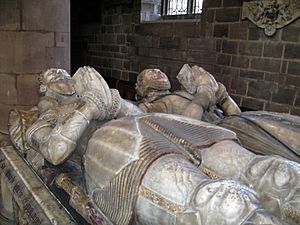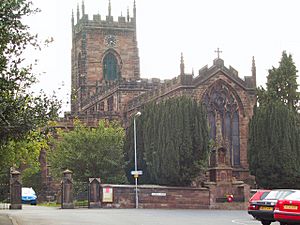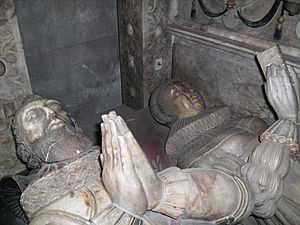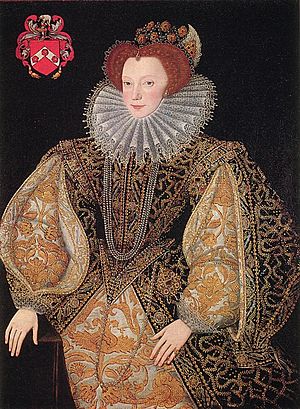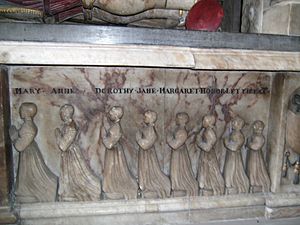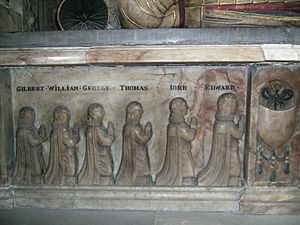Edward Littleton (died 1610) facts for kids

Sir Edward Littleton (around 1555–1610) was an important landowner in Staffordshire, England. He was also a politician and was involved in a rebellion. He belonged to the well-known Littleton family. Sir Edward supported Robert Devereux, 2nd Earl of Essex, a powerful nobleman. In 1597, he was unfairly treated in an election. Later, he took part in the Essex Rebellion, but luckily, he was not killed. When King James I became king, Sir Edward was chosen to be a member of the parliament of England.
Contents
Family Background
Sir Edward Littleton's father was also named Edward Littleton (died 1574). He lived at Pillaton Hall, a large house near Penkridge. His mother was Alice Cockayne (1535–1602). She was the daughter of Francis Cockayne from Ashbourne Hall, Derbyshire.
The Littleton family had lived at Pillaton since the early 1500s. Sir Edward's grandfather, Sir Edward Littleton, was very good at growing the family's land during the time of the English Reformation. He also represented Staffordshire in five different parliaments. Sir Edward's father kept the family's land strong but mostly lived a quiet life as a country gentleman.
Becoming a Landowner
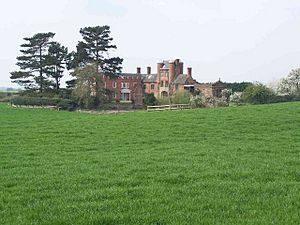
Sir Edward Littleton took over the family lands in 1574 when his father died. He had recently married Margaret Devereux in 1573. Littleton inherited a huge amount of land: 16,000 acres near Penkridge and another 600 acres in other parts of Staffordshire. He also owned land in Warwickshire, Shropshire, and Worcestershire.
His mother lived until 1602. She had a right to use a large part of the family's wealth, which Sir Edward later said made it hard for him financially. However, when his father-in-law, Sir William Devereux, died in 1579, it probably helped him a lot, as Devereux left money to his daughters. Sir Edward was clearly rich and important enough to be the High Sheriff of Staffordshire twice, in 1581 and 1593. He was a very wealthy landowner and important in his region.
Even with financial demands, Littleton found money to buy important properties. One key source of the Littletons' wealth came from renting land, especially from the former college of St. Michael in Penkridge. Sir Edward's grandfather had rented land from the church in 1543. In 1585, Edward Littleton was able to buy the college property completely. This land, later called the deanery manor, stayed with the Littleton family for a long time. With it, they gained many rights, including control over the church. This meant the Littleton family chose the church leaders and kept the parish separate from the Diocese of Lichfield until 1858.
Many of the Littleton family's lands were still held under old feudal land tenure rules. Even though the old system of trading land for military service was no longer used, the Littletons still paid 16 shillings a year to their powerful lord, Baron Paget, for their Pillaton manor.
Political Life
The Paget Connection
After he inherited his lands, Littleton seemed to be politically close to his powerful lord, Thomas Paget, 3rd Baron Paget. Lord Paget was a well-known Catholic nobleman. However, in the 1580s, Lord Paget and his brother Charles fled to France. They were involved in the Babington Plot, a plan to kill Queen Elizabeth I. Lord Paget lost all his lands and went to live in Spain.
Littleton had supported Paget in their local area, but he did not share Paget's religious beliefs. He was not harmed by Paget's downfall. In fact, Amias Paulet, a very strict Protestant, thought Littleton was one of the few trustworthy gentlemen in Staffordshire. He called him "a very honest religious gentleman."
Supporting the Earl of Essex
From the late 1580s, Edward Littleton and most of his relatives were very close to Robert Devereux, 2nd Earl of Essex. Even when Essex was at university, Edward Littleton gave him a horse, looking to the future. Edward Littleton's wife, Margaret Devereux, was a cousin of the Earl. Essex saw Staffordshire as his own county and a place where he had a lot of power. Essex's main home, Chartley Castle, was in Staffordshire, and Littleton's brother, James, managed it for him. Essex's mother, Lettice Knollys, lived nearby. She even became the godmother to Edward Littleton's daughter, Laetitia.
Essex was a powerful figure in Queen Elizabeth's court. He became a leader for those who wanted to be more aggressive against Spain. A group of Staffordshire landowners, including the Littleton, Bagot, Chetwynd, Trew, and Aston families, formed a local group to support Essex. Even the Worcestershire Lytteltons, another part of the family, were involved. They strongly disliked Edward Sutton, 5th Baron Dudley, who was Essex's main enemy in the region.
In the 1590s, Edward Littleton helped Essex in parliamentary elections. Essex began to take a strong interest in who was elected for Staffordshire. The members chosen in 1588, Walter Harcourt and Thomas Gerard, were both later knighted by Essex.
The 1593 Election
Essex tried to control the 1593 election, which caused some problems. On January 2, 1593, Essex wrote to Sir Edward Littleton and others, telling them to make sure his step-father, Christopher Blount, was elected. A week later, he wrote again, asking them to support Gerard as the second member. He added that he would feel his influence was small if he couldn't get this small thing done in his own county.
However, Sir William Harcourt also wanted to run, and he was also a supporter of Essex. Then Gerard decided to run in Lancashire, which meant he would support Harcourt. Essex did not change his instructions, leaving Littleton confused. Littleton wrote that if Gerard allowed them to support Harcourt, he didn't know what more they could do. Despite the confusion, Blount and Harcourt were elected for Staffordshire.
The Essex Rebellion
After having problems with Queen Elizabeth over the Irish war, Essex felt left out by the Queen's advisors. He decided to try a sudden takeover of the government on February 8, 1601. He wanted to make James VI of Scotland the next king. Sir Edward Littleton was accused of being part of the armed group that planned this. The Essex Rebellion turned into a disaster, with Essex's supporters marching through London without success. The plotters were quickly caught. By February 12, Littleton was on a list of known plotters.
Littleton's role in the events seemed quite strange. He claimed he only visited Essex House to hear a sermon. When there wasn't one, he left. He said he was then arrested for a debt but was released by his sister. He and his brother James then went to look for another sermon. He claimed they were then forced to go along with Essex's armed group out of fear. As soon as they heard that Essex and his supporters were declared outlaws, the Littletons escaped and hid in a shop. Sir Edward explained that he didn't report to the authorities the next day because he was tired.
After he was questioned, Littleton's case was handled quickly. He was lucky to escape with his life, though he lost his position as a judge in Staffordshire and had to pay a large fine of £400. He wrote to a powerful official, asking for easier payment terms. He explained that his wealth was divided, and he had 13 children to support. His mother's death in 1602 probably helped his money situation, and he was given back his judge position in June of that year. This suggests that his explanations were believed, and the more serious accusations against him were not.
Member of Parliament
When King James I became king in 1603, the political problems of Elizabeth's last years were forgotten. Many people who had been in trouble, like William Paget, 4th Baron Paget and Robert Devereux, 3rd Earl of Essex, were promised their family lands and titles back. Thomas Gerard, who had supported Essex, was also made a lord. In the Staffordshire election of March 1604, powerful noble families regained their influence.
The Essex supporters, who were mostly Protestants, planned carefully. To avoid splitting the votes, they put forward only one candidate: Edward Littleton of Pillaton. They agreed that the other seat would go to the Paget family's choice, Sir Robert Stanford. Stanford was a Protestant leader of a Catholic family, like Paget himself. He was accepted by both Catholic and Protestant gentlemen. Littleton noted that people joked the election was more about choosing a pope than a knight for Parliament because so many Catholics were involved.
However, this plan faced a problem from Sir Walter Harcourt, who had been a good friend and an Essex supporter. Harcourt was deeply in debt and believed Littleton was working with his creditors. He tried to cause trouble, even trying to get Littleton declared an outlaw. But Harcourt's own debts forced him to stop. Littleton thanked the sheriff, Walter Bagot, for keeping him informed by sending him two horses. As a result, Littleton was elected without opposition alongside Stanford, probably on March 15.
Littleton was made a member of eight committees in Parliament. One of these committees worked on giving back the lands and titles to the Earls of Essex, Southampton, and Arundel, who had been punished after the Essex rebellion. In April, he also joined a meeting with the House of Lords about a plan to unite England and Scotland. He continued his work in Parliament, joining a committee about poaching.
However, after a strong start, Littleton's involvement in Parliament quickly lessened after 1604. This might have been because of his land disputes. He was fined in 1609 for problems during his feud with another landowner. But it was also likely due to his health getting worse.
The Parliament lasted for seven years, longer than both Stanford and Littleton lived. Stanford was replaced in 1607. In 1610, local leaders sent a message to Parliament saying that Littleton was dying. A new election was ordered on October 19. On November 15, Francis Trentham was chosen to replace Littleton as the representative for Staffordshire.
Death
Sir Edward Littleton died on December 17, 1610. He was buried at the church of St Michael and All Angels in Penkridge the next day. Later, a large and impressive tomb was built for him and his wife, Margaret Devereux, who lived until 1627.
Margaret Devereux officially handled his will on February 14, 1611.
Marriage and Family
Edward Littleton married Margaret Devereux. She was the daughter of Sir William Devereux of Merevale Hall, Warwickshire. Sir William's father was Walter Devereux, 1st Viscount Hereford, who was the great-grandfather of Robert Devereux, 2nd Earl of Essex. This means Essex was Margaret Devereux's first cousin once removed. The name Devereux was often used by the Littletons as a given name for their younger sons for many years.
Littleton and Margaret had 14 children, but many of them did not live past childhood. Their fifth child, and third son, Edward Littleton, took over his father's lands. All 14 children, six sons and eight daughters, are shown on the front of their tomb in St. Michael's church, Penkridge. The tomb also has statues of their son Edward, who took over the estates, and his wife, Mary Fisher, on a higher level.
See also
- History of Penkridge
- Littleton Baronets



